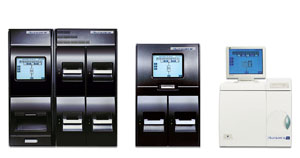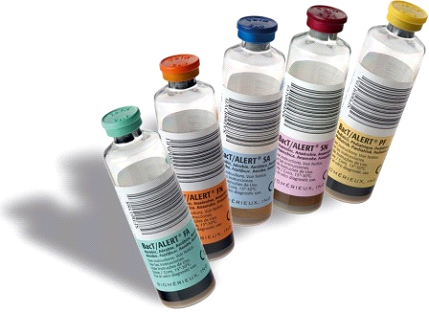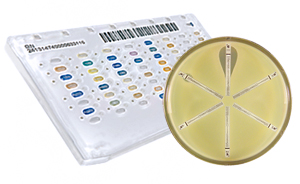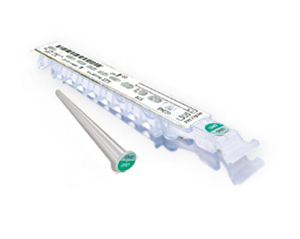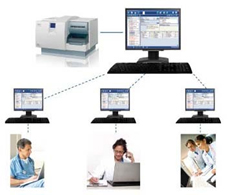Sepsis Management

Sepsis, a systemic inflammation due to infection, can lead to severe sepsis and septic shock. These serious conditions incur long hospital stays, and high morbidity and mortality. The Surviving Sepsis Campaign’s latest guidelines (2012) offer very clear strategies for better patient outcomes. When time is critical, you need accurate information – and you need it fast. bioMérieux is your partner along the sepsis management pathway, bringing you rapid and reliable results to support clinical decisions for better patient care.
Sepsis: every minute counts
|
Treat sepsis early – save lives “Rapid initiation of simple, timely interventions, including antimicrobials and intravenous fluids, can reduce the risk of death by half. Patients with suspected sepsis should be referred immediately to an appropriate facility. Early sepsis treatment is cost effective, and reduces the number of hospital and critical care bed days for patients” |
Sepsis is a complex inflammatory process that is largely under-recognized as a major cause of morbidity and mortality worldwide. Yet, with 20 to 30 million cases each year worldwide, sepsis causes 1 death every 3-4 seconds1. It is caused by an acute response of the body’s immune system to a severe infection. Severe sepsis leads to organ dysfunction and if hypotension persists, the body can go into septic shock, a frequently fatal condition2,10. Long-term effects for sepsis survivors include permanent organ damage, as well as physical and cognitive disability3,4.
Despite medical advances, severe sepsis is rising rapidly5,6,10. Along with rising incidence,there are rising costs: in the US, hospital treatment costs rose 11.9% between 1997 and 20085; in Germany, costs for treating a typical case are reported to have more than doubled in the last decade7.
The “Golden hour”
Early diagnosis and appropriate treatment make a critical difference when it comes to improving sepsis patient outcomes. Indeed, chances of survival go down drastically the longer initiation of treatment is delayed. If a patient receives antimicrobial therapy within the first hour of diagnosis, chances of survival are close to 80%; this goes down by 7.6% for every hour after. Yet, if a patient initially receives inappropriate antimicrobial treatment, they are five times less likely to survive9.
Updated guidelines: protocols for efficient response
The Surviving Sepsis Campaign, a joint collaboration of the Society of Critical Care Medicine and the European Society of Intensive Care Medicine, most recently published the third edition of its guidelines: Surviving Sepsis Campaign: International Guidelines for Management of Severe Sepsis and Septic Shock: 201210. Based on a wide body of research, these guidelines offer key recommendations to ensure best patient outcomes.
The Surviving Sepsis recommendations start with initial resuscitation and carry through 10 recommendations of care and monitoring, along with special considerations for pediatrics10. The microbiology laboratory plays a vital role throughout the sepsis management pathway, in particular for some of the most critical recommendations: routine patient screening, diagnosis and antimicrobial therapy.
Some key Surviving Sepsis recommendations (summarized)*
*Full guidelines available at: http://www.sccm.org/Documents/SSC-Guidelines.pdf |
Clinicians depend upon rapid and reliable diagnostics for clinical decision-making every step of the way. So how can in vitro diagnostics help you meet that challenge?
Early patient management in sepsis
When a patient presents with suspected sepsis, appropriate cultures (blood samples or samples from site of infection) should be obtained within the first hour, before starting antimicrobial therapy. Biomarkers such as procalcitonin (PCT) may also rapidly (20 minutes) give answers to support diagnosis or prognosis. To initiate appropriate therapy as early as possible, it is important not only to identify the pathogen, but also to test for resistance to antimicrobials. Antibiotic treatment effectiveness must be monitored continually. Finally, epidemiological surveillance and antimicrobial profiling help determine local epidemiology and hospital antimicrobial policies.
At bioMérieux, we understand that each of these steps is not an isolated activity but rather a continuum of care that involves close collaboration between the microbiology lab and the clinical care setting. That’s why we’ve developed a global patient-centric solution for sepsis to support you all the way along the continuum. We understand that actionable laboratory results lead to informed clinical decisions and improved patient outcomes.
|
Surviving Sepsis recommendations |
bioMérieux supports your needs |
|
|
DIAGNOSIS
|
Blood cultures |
|
|
Site specific cultures Conventional culture media |
||
|
Microbial identification / Antimicrobial resistance testing |
||
|
Procalcitonin (PCT) immunoassay VIDAS® B·R·A·H·M·S PCT™ |
||
|
ANTIMICROBIAL THERAPY
|
Antimicrobial resistance profiles/Rapid result reporting VITEK® 2 / Advanced Expert System™ |
|
A partner you can count on for sepsis management
|
By microbiologists, for microbiologists bioMérieux solutions are designed by microbiologists, for microbiologists. With more than 50 years’ experience working with laboratories, we’ve been by your side throughout the evolution of challenges facing labs around the world, including the growing threat of sepsis. |
bioMérieux is acutely aware of the challenges the microbiology lab faces daily in the fight against sepsis and the need for leading-edge diagnostics. Along with our continual innovation in rapid diagnostic solutions and tests, we are also a sponsor of World Sepsis Day.
Like you, providing the best possible patient care is at the heart of our concerns. So you can count on us to be by your side, facing the sepsis management challenge.
References:
- WSD fact sheet 2013/www.world-sepsis-day.org
- Angus DC, et. al. Epidemiology of severe sepsis in the United States: Analysis of incidence, outcome and associated costs of care. Crit Care Med 29 (7) : 1301-10. 2001
- Iwashyna, TJ, et. al. Long-term cognitive impairment and functional disability among survivors of severe sepsis. JAMA 304(16):1787–94. 2010.
- Chang HJ; et. al. (2010) Sepsis. JAMA 304 (16):1856.
- Hall, Margaret Jean, et. al. (2011). Inpatient Care for Septicemia or Sepsis: A Challenge for Patients and Hospitals. NCHS Data Brief. No. 62
- International Organizations Declare Sepsis a Medical Emergency. Issued by an expert panel representing 20 adult and pediatric intensive care societies, October 4th 2010. 2010: Press release. http://www.prnewswire.com/news-releases/international-organizations-decl...
- Vincent JL, et al. Sepsis in European intensive care units: results of the SOAP study. Crit Care Med, 34:344-353, 2006.
- Kumar, A, et. al. Duration of hypotension before initiation of effective antimicrobial therapy is the critical determinant of survival in human septic shock. Crit Care Med. 2006 Jun;34(6):1589-96.
- Kumar, A, et. al. Initiation of inappropriate antimicrobial therapy results in a fivefold reduction of survival in human septic shock. Chest. 2009 Nov;136(5):1237-48.
- Dellinger RP, et al. “Surviving Sepsis Campaign: International Guidelines for Management of Severe Sepsis and Septic Shock: 2012”. Crit Care Med. 2013 Feb;41(2):580-637



